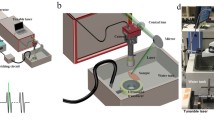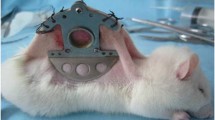Abstract
The relationship between photothermal damage to blood vessels of diameter,d, and laser pulse duration,t p, was verified in a series of studies using the chick chorioallantoic membrane (CAM). A total of 879 individual CAM blood vessels (d=50–130μm) was irradiated, using a laser pulse duration of 0.45 or 10 ms. Laser-induced vascular damage was observed in real time, recorded on videotape, and evaluated in a double-blind fashion. Permanent damage was confirmed by inspection 24 h after laser exposure. Under the conditions of this experiment, only when laser pulse durations are approximately equal to the estimated thermal relaxation times (τ) of the CAM microvessels can the critical core intravascular temperature, necessary to destroy vessels irreversibly, be achieved and sustained for sufficient time. Shorter pulse durations are more effective for damaging smaller blood vessels; conversely, longer pulse durations are more effective for damaging larger diameter vessels.
Similar content being viewed by others
References
Anderson RR, Parrish JA. Selective photothermolysis: precise microsurgery by selective absorption of pulsed radiation.Science 1983,220:524–7
Barsky SH, Rosen S, Geer DE, Noe JM. The nature and evolution of port wine stains: a computer assisted study.J Invest Dermatol 1980,74:154–7
Kimel S, Svaasand LO, Hammer-Wilson M et al. Differential vascular response to laser photothermolysis.J Invest Dermatol 1994,103:693–700
Fuchs A, Lindenbaum ES. The two- and three-dimensional structure of the microcirculation of the chick chorioallantoic membrane.Acta Anat 1988,13:271–5
Knighton D, Ausprunk D, Tapper D, Folkman J. Avascular and vascular phases of tumor growth in the chick embryo.Br J Cancer 1977,35:347–56
Kimel S, Svaasand LO, Hammer-Wilson M et al. Demonstration of synergistic effects of hyperthermia and photodynamic therapy using the chick chorioallantoic membrane model.Lasers Surg Med 1992,12:432–40
Gradshteyn IS, Ryzhik IM. In: Jeffrey A (ed)Table of Integrals, Series and Products, 4th edn. San Diego: Academic Press, 1980
Mathematical tables projects: table of Struve functions Lv(x) and Hv(x).J Math Phys 1946, 25:252–9
van Gemert MJC, Welch AJ, Miller ID, Tan OT. Can physical modeling lead to an optimal laser treatment strategy for port-wine stains? In: Wolbarsht ML (ed)Laser Applications in Medicine and Biology, Vol. 5. New York: Plenum Press, 1991: 199–275
Paul BS, Anderson RR, Jarve J, Parrish JA. The effect of temperature and other factors on selective microvascular damage caused by pulsed dye laser.J Invest Dermatol 1983,81:333–6
Geronemus RG. Pulsed dye laser treatment of vascular lesions in children.J Dermatol Surg Oncol 1993,19:303–10
Nelson JS, Jacques SL, Wright WH. Determination of thermal and physical properties of port wine stain lesions using pulsed photothermal radiometry.SPIE 1992,1643:287–98
Jacques SL, Nelson JS, Wright WH, Milner TE. Pulsed photothermal radiometry of port-wine-stain lesions.Appl Optics 1993,32:2439–46
Milner TE, Norvang LT, Svaasand LO et al. Photothermal tomography of subcutaneous chromophores.SPIE 1993,2077:228–36
Author information
Authors and Affiliations
Rights and permissions
About this article
Cite this article
Stuart Nelson, J., Milner, T.E., Svaasand, L.O. et al. Laser pulse duration must match the estimated thermal relaxation time for successful photothermolysis of blood vessels. Laser Med Sci 10, 9–12 (1995). https://doi.org/10.1007/BF02133157
Received:
Issue Date:
DOI: https://doi.org/10.1007/BF02133157




